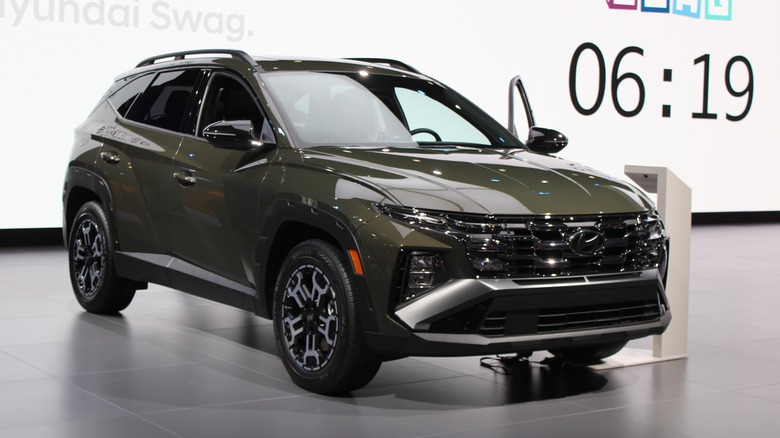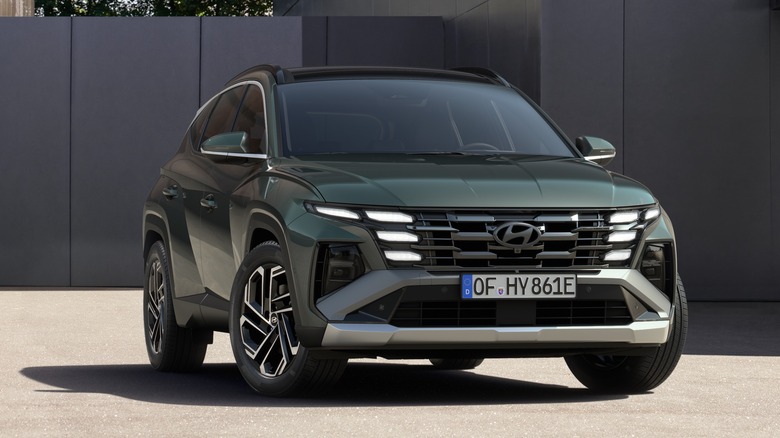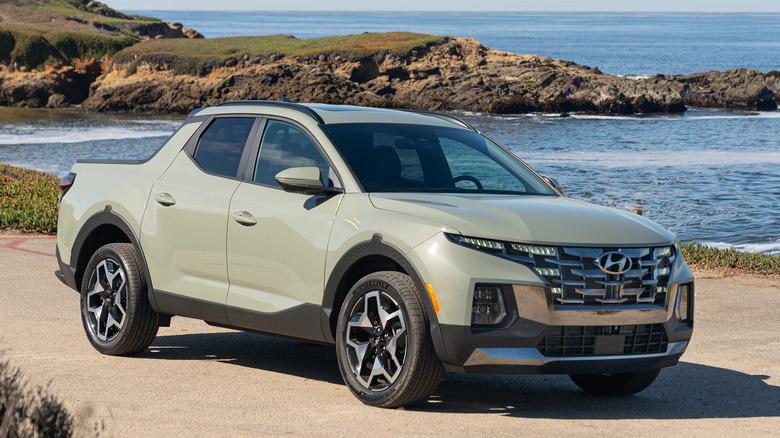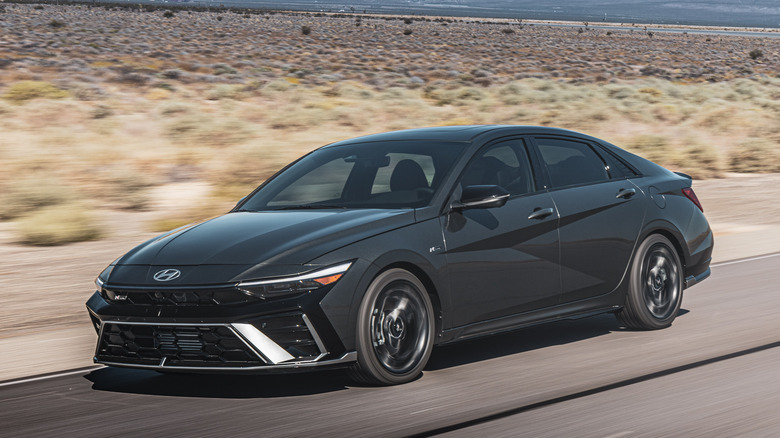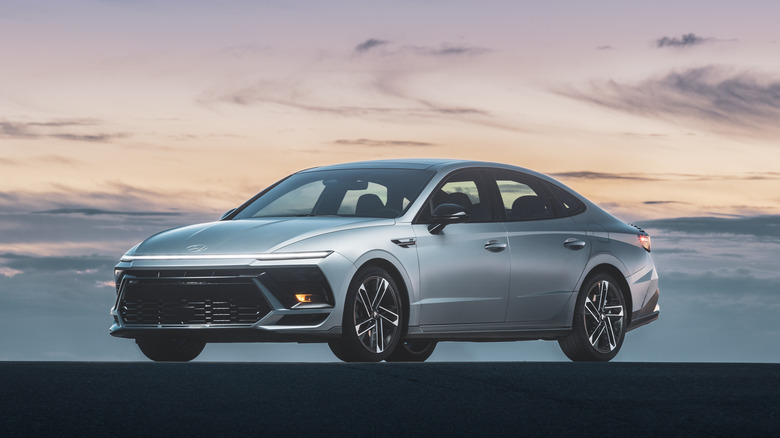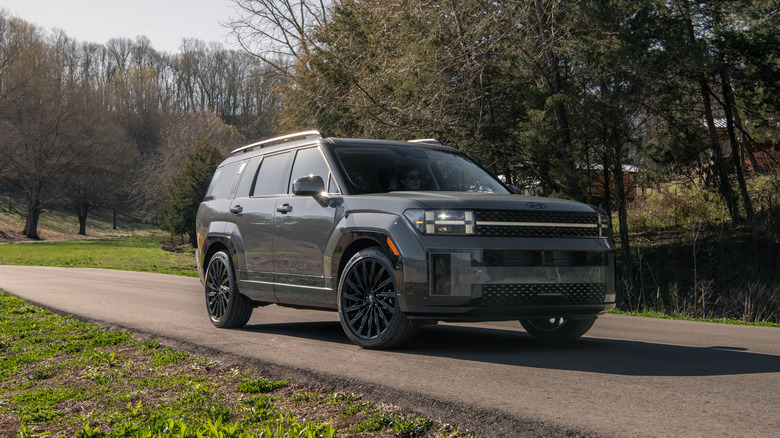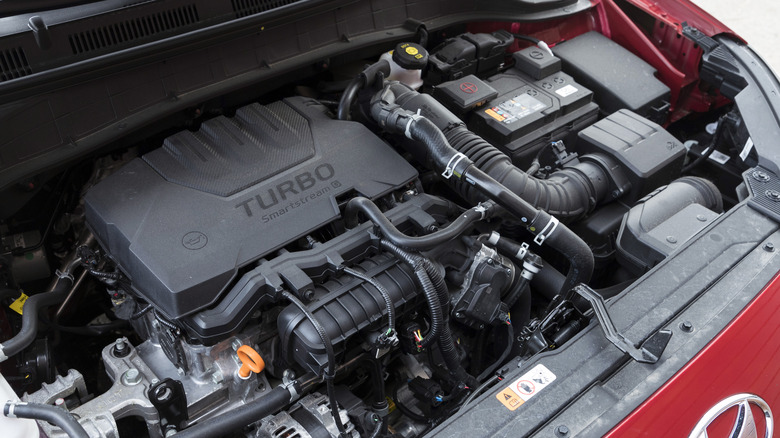Every Hyundai Model Made In The U.S.A.
It took South Korea a long time to join the global automotive market. It takes a lot of bravery to join the global market no matter who you are, as it has proven to be a place of prejudice and fierce competition. Still, that didn't stop the Korean automakers Kia and Hyundai from entering North America in the 1980s and 1990s.
The two's response from the public wasn't exactly the greatest straight away. Hyundai quickly developed a reputation for poor build quality and made price the single reason why anyone would buy one. Fast-forward to today and things couldn't be more different.
Hyundai has risen to the top of the automotive world, at least in the more ordinary consumer car space. The automaker consistently knocks it out of the park with build quality, features, pricing, and even reliability. With such a huge presence in the North American market, it's no surprise that Hyundai has a local facility in Montgomery, Ala. As of 2024, Hyundai Motor Manufacturing Alabama assembles six different models in addition to many of the company's engines.
Tucson
One of America's favorite compact SUVs, the fourth and current generation Tucson, was introduced back in 2020. It was one of the first production models from the Korean automaker that signified the arrival of a much braver, and much more out-there design philosophy — evident in the twin-fang tail light design, the sharp creases, and the bold geometric front grille with those ever-popular upside-down headlights.
The latest Tucson offers a great amount of choice in terms of trim levels, and most of them have pretty good standard equipment, and a host of power units that include conventional gas, hybrid, and plug-in hybrid. Starting at just $27,500, the Tucson is incredible value for money. If you have the patience, a refreshed Tucson is coming with updated exterior styling and a completely revamped interior.
Powertrains include a variety of four-cylinder engines, with the base model making 187 horsepower, while the hybrid goes up to 226, and the plug-in hybrid offers up a maximum of 261 horsepower.
While Tucsons for other markets are assembled in various locations around the world, including India and the Czech Republic, U.S. specification Tucsons are built in Montgomery, right alongside its pickup counterpart, the Santa Cruz.
Santa Cruz
The start of the 2020s signified the return of a once-forgotten trend in the automotive world — well, besides the countless others that drive many enthusiasts up the wall. The compact pickup truck returned at the beginning of the decade, and Ford and Hyundai entered the ring first, with the Maverick and Santa Cruz, respectively.
While not bad for a first attempt at a pickup truck, Hyundai never offered such a vehicle to North America. While the Santa Cruz was no F-150 or Silverado, it provided a surprising amount of utility with a pretty healthy dose of style. It was also pretty refined, thanks, in part, to being based on a car platform rather than a ladder frame, as you'd expect to find in most other pickup trucks.
The Santa Cruz' utility is made possible thanks to some potent powertrains, including a turbo four-banger with 281 horsepower. While it might not have the greatest fuel economy, it makes up for in payload and towing capacity, two very important stats when talking about pickups. In the correct guise, the Santa Cruz can tow up to 5,000 pounds and carry up to 1,753 pounds in the bed.
The Santa Cruz is manufactured in Alabama (which gets around the chicken tax, of course), right alongside its cousin, the Tucson.
Elantra
Thankfully, unlike some other automakers, Hyundai hasn't abandoned regular cars altogether. We totally understand SUV fatigue, and despite automakers urging us to think otherwise, SUVs really aren't for everyone. As luck would have it, Hyundai still offers the Elantra, which has morphed from a laughing stock akin to the Kia Sephia to a serious contender in the world of compacts.
The Elantra is an alternative to all the Jettas and Civics of the world, and in a lot of ways, it's a fantastic contender. Sure, the Mazda 3 is classically beautiful, but the Elantra is definitely striking and interesting to look at, which is not something you could really say about its predecessors.
It's also packing a multitude of standard features and safety tech, and yet it starts from under $22,000. If the regular Elantra is a little too pedestrian, the excellent Hyundai Elantra N and its 271 horsepower turbo four can save the day.
Sonata
One category of cars that is still doing somewhat well even during the SUV craze is the mid-size sedan. The Camry and Accord are still doing great numbers, and for decades, the Hyundai Sonata lived in their shadow. Nowadays, it's a totally different story. The latest Sonata, which came along in 2019, was radically different from its predecessors, and it's definitely a looker.
A 2024 facelift changed the styling even more, which made it seem like a completely new generation model. One of the people responsible for that eye-catching exterior is Luc Donckerwolke, the man behind the Bentley Continental GT and the Lamborghini Murcielago. In other words, somebody who knows his stuff when it comes to automotive design.
As seems to be Hyundai's motto, the Sonata is packed with features even on the base model, and it's so spacious inside, it can technically be considered a full-size sedan. A frugal hybrid powertrain allows for up to 39 mpg, while also putting out a very useful 290 horsepower. All of that for a starting price of around $27,000 is pretty tough to beat. The Accord and Camry may be the leaders, but the Sonata definitely challenges their right to the throne.
Santa Fe
At one point, the Santa Fe was Hyundai's largest SUV until the Palisade took that crown. Not too long ago, the Santa Fe offered some decent value for money, although its styling leaned more on the conservative side. The latest generation of Santa Fe, which recently went on sale, is something entirely different. Hyundai's designers continue to introduce exciting new directions and styling elements in every model, and the Santa Fe is no different, with its H-shaped headlight signature, Horizon light bar in the front grille, and the very low-mounted taillights.
Of course, that's not even touching the elephant in the room: how unapologetically boxy the new Santa Fe is. The previous generation, although fairly boxy, was still a pretty conservative in terms of styling, but the latest one seems very intent on making a statement with its looks, and it successfully achieves just that. The ultra-boxy shape also means plenty of room inside, even in the third row of seats.
There's plenty of tech and features as standard, and Hyundai have also managed to squeeze almost 300 horsepower out of the new Santa Fe in certain models, which should be plenty of power to transport a family and all their belongings. The surprisingly excellent new Santa Fe joins the aformentioned models as one of Hyundai's vehicles manufactured at the Montgomery facility.
Bonus: Smartstream Engines
As well as the five above-mentioned passenger vehicles, the manufacturing plant in Montgomery also has another task. It's the plant where Hyundai assembles the Smartstream engines that power virtually all of its models that still run on internal combustion.
Smartstream is the latest and current generation of the Hyundai Motor Group's internal combustion engine, and it's packed with highly innovative features. The Smartstream engines are designed from the get-go to work with and respond well to electrification for the group's self-charging and plug-in hybrids.
Continuously Variable Valve Duration allows for better piston compression, while dual fuel injectors atomize the fuel, which allows for a much better fuel-air ratio. The Smartstream designation is worn by everything from a tiny 1.0-liter I3 with multi-point fuel injection, all the way to the big daddy 3.5-liter turbo V6, as well as the electric-supercharged 3.5 V6 that is doing service in the latest Genesis G90.
